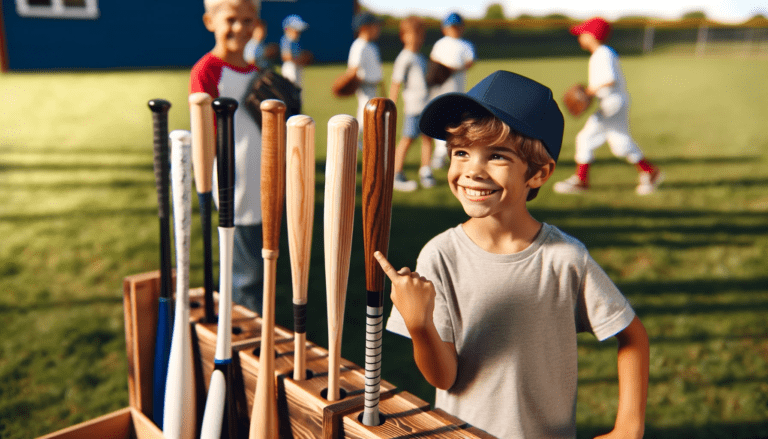Can You Use a Baseball Bat for Softball?
Have you ever wondered if you can use a baseball bat for softball? The short answer is no, it’s not recommended.
When picking the right gear for softball, many think that a baseball bat will do the trick. But, there’s a catch. Baseball and softball bats are designed differently, each optimized for the specific sport’s ball size slow pitch, and playing style.
Using a baseball bat for softball might seem like an easy solution, but it can affect your game and the softball bat’s durability.
Let’s explore why it’s important to choose the right bat for your game.
Key Takeaways
- Baseball bats can be used for various purposes including softball, training, and self-defense, but their compliance with official softball regulations is crucial for gameplay.
- Material and construction of baseball bats, such as aluminum alloy, can affect their suitability for softball and impact durability, with some bats not withstanding the rigors of regular use.
- Training bats and tools are available to enhance hitting skills in softball, focusing on aspects like bat speed, timing, and strength, though they are not always meant for use with actual baseballs or softballs.
- When selecting a bat for softball, it is important to consider the bat’s weight, length, and construction to ensure it aligns with the player’s skill level and league regulations for maximum performance.
- Safety considerations are paramount when using baseball bats in softball, as using non-compliant or inappropriate equipment can pose risks to players and affect the integrity of the game.
Understanding the Differences Between Baseball and Softball Equipment
Regulation Specifications for Bats
When it comes to playing baseball or softball, the bat is a crucial piece of equipment that must adhere to specific regulations. Understanding these specifications is essential for compliance and optimal performance.
For instance, in baseball, bats must have the “USA Baseball” factory stamp to be considered legal for play. Any deviation from this standard results in the bat being deemed non-compliant, and its use can lead to an immediate out being called.
Softball bats also have their own set of rules that must be followed. These regulations are updated periodically, and players and coaches need to stay informed about the current standards.
For example, the bats used in Minor League Baseball must be less than 33 inches long and cannot have a barrel diameter exceeding 2 5/8 inches. This ensures a level playing field and maintains the integrity of the game.
Here are some key points to remember about bat regulations:
- Bats must feature the appropriate certification mark.
- Length and barrel diameter restrictions apply.
- The material and construction of the bat are also regulated.
- Non-compliance can result in penalties such as outs or ejections from the game.
Impact of Bat Material on GamePlay
The material of a bat significantly influences its performance in both baseball and softball.
Softball bats are thinner and longer than their baseball counterparts, with players often opting for lighter materials to enhance swing speed and control.
This difference in design and material affects the bat’s weight distribution and swing dynamics.
- Lightweight bats allow for faster swing speeds, which can lead to better contact with the ball and potentially more powerful hits.
- Shock absorption is another critical factor, with slim handles and anti-skid rubber grips helping to reduce vibration and improve comfort during play.
However, not all bats are suitable for competitive play. Some bats, designed for casual or practice use, may not withstand the impact of serious gameplay, leading to damage such as dents or bends.
It’s essential to choose a bat that is not only comfortable and enhances performance but also durable enough to endure the rigors of the game.
Safety Considerations for Players
When it comes to player safety, the choice of bat can play a pivotal role. Using the wrong type of bat not only affects performance but can also pose a risk to players.
For instance, bats that are too heavy or improperly balanced may lead to strain injuries or accidental collisions during swings.
Key safety considerations include:
- Ensuring bats have the appropriate safety certifications, such as the “USA Baseball” factory stamp.
- Selecting bats that match the player’s strength and skill level to prevent strain or injury.
- Adhering to league rules regarding bat usage to avoid penalties and maintain a safe playing environment.
It’s crucial for players and coaches to be aware of the equipment regulations and to use only league-approved gear.
This includes not only bats but also protective equipment like helmets and catcher’s gear. Compliance with these rules helps to minimize the risk of injury and ensures a fair and safe game for all participants.
Read Also: Can I Bring a Baseball Bat on an Airplane
The Versatility of Baseball Bats Across Different Uses

From Sports to Self-Defense: A Multifunctional Tool
Baseball bats, particularly those made from aluminum alloy, are not only essential for hitting home runs but also serve as a robust tool for self-defense.
The durable and sturdy nature of these bats makes them a reliable option for protection against potential threats.
In emergencies, wielding a baseball bat can provide a significant advantage, offering both a sense of security and the means to defend oneself.
The versatility of baseball bats extends to various levels of sports, from amateur to professional, and is suitable for different forms of the game, including softball and T-ball. Their multifunctional use is further enhanced by design elements that cater to self-defense needs, ensuring the adult baseball bat can serve purposes beyond the diamond.
For instance, a well-balanced wood bat, not only improves a player’s swing but also allows for a powerful and controlled response in a self-defense scenario.
When selecting a baseball bat for any use, it’s important to consider the specifications, such as length and weight, to ensure it meets your needs.
A bat with a sleek design and high gloss finish can be particularly appealing, standing out not just in sports but also as a tool for personal safety.
Training and Practice: Adapting Baseball Bats for Softball
When it comes to training and practice, baseball bats can be adapted for softball to focus on improving swing mechanics.
Using a training bat can help a hitter and coach emphasize the fundamentals of a good swing. These specialized bats often come with features that exaggerate incorrect movements, allowing the user to identify and correct them.
For instance, a flexible shaft can teach the hitter to lead with the hands and ‘throw the barrel’, which is crucial for developing a proper swing path.
Training bats are also beneficial for self-coaching, enabling players to improve on their own. They are especially useful in the on-deck circle, where hitters prepare for their turn at bat.
However, it’s important to note that these bats are not meant for use with actual baseballs or softballs but may come with mini-training balls designed for practice purposes.
Here are some advantages of using training bats:
- Increases bat speed
- Improves hitter’s timing
- Provides immediate feedback for swing adjustments
By incorporating training bats into practice sessions, players can work on increasing speed and power with every hit, potentially breaking out of hitting slumps and refining their batting technique.
Limitations of Using Baseball Bats in Official Softball Games
While baseball bats may be in fast pitch softball game used for practice or recreational softball, their use in official games is highly restricted.
Official softball leagues have specific regulations that must be adhered to, which often exclude the use of baseball bats.
For instance:
- ALL baseball bats must bear the “USA Baseball” factory stamp for use in baseball games.
- Conversely, softball bats must comply with separate regulations, typically not allowing the crossover use of baseball bats.
Using a non-compliant bat in a game can lead to immediate penalties, such as the batter being called out. This is treated as a dead ball situation play baseball, where all runners must return to their bases before the hit.
Players and coaches must understand these rules to avoid game disruptions and ensure fair play.
Moreover, the differences in bat specifications between the two sports can impact player performance and safety, making compliance not just a matter of rules but also sportsmanship and integrity.
Read Also: Why Are Baseball Bats So Expensive
Maximizing Player Performance with the Right Equipment

The Role of Bat Weight and Length in Batting Power
Bat weight and length are crucial factors in determining the power behind a swing. A heavier weight of bat can increase the force of impact, but it may also slow down the swing speed.
Conversely, a lighter bat allows for quicker swings, potentially leading to better contact with the ball.
- The distribution of weight throughout the bat affects balance and swing mechanics.
- A balanced weight distribution and an ultra-light drop-weight design can lead to faster swing speeds.
- Training with weighted bats or bat weights can help players build strength and improve their swing power.
Players need to find the right balance between weight and length that suits their playing style.
Training tools like the CamWood Hands and Speed Trainer can assist in reinforcing proper swing mechanics while building strength.
Ultimately, the goal is to maximize batting power without compromising speed or control.
Training Bats and Tools to Enhance Hitting Skills
Training bats and specialized tools are essential for players looking to refine their hitting skills. Using a training bat can significantly improve a player’s swing mechanics by providing immediate feedback on the swing path, allowing for quick adjustments and improvements.
These bats often come with features such as a flexible shaft or audible feedback mechanisms that highlight incorrect movements, prompting the hitter to correct them on the spot.
Key benefits of using training bats include:
- Increased bat speed
- Improved timing
- Enhanced ability to lead with the hands and ‘throw the barrel’
Moreover, training bats are not only for individual practice but also beneficial during team drills and in the on-deck circle. However, it’s important to note that they are not meant for use with actual baseballs or softballs but may come with specialized mini training balls.
Whether you’re breaking out of a slump or working to increase power, incorporating a variety of training bats into your regimen can lead to more effective batting practice sessions.
Choosing the Appropriate Bat for Different Skill Levels
Selecting the right bat is crucial for players at all levels, but it becomes particularly important as skill levels vary.
Deciding between a one-piece or two-piece bat can be a tough decision. It mainly depends on your skill level and level of play.
For beginners, a lighter bat may be more beneficial as it allows for greater control and helps in learning the fundamentals of batting a fast pitch.
Intermediate players might opt for a bat that balances weight and power, providing a blend of speed and force.
Advanced players often choose heavier bats to maximize power, assuming they have the strength and skill to handle them effectively.
When considering bat options, it’s also worth looking into specialized training bats. These bats are designed to improve specific aspects of a player’s swing.
For example, bats like the ProVelocity Bat and the Insider Bat focus on the swing path and provide immediate feedback, which is invaluable for correcting technique.
Additionally, using bat weights and weighted bats can help build power and speed, essential for enhancing performance at any level.
Ultimately, the choice of bat should align with the player’s development goals and the level of competition they are engaged in.
Whether it’s for practice or official matches, the right bat can make a significant difference in a player’s hitting ability and overall performance.
Conclusion
In summary, while baseball bats can be versatile tools for various activities, including self-defense and training, their suitability for both softball and baseball bats is not universal. The construction and specifications of a bat greatly influence its appropriateness for the sport.
Lightweight, hollow wood bats may not withstand the impact of a softball game, leading to damage and safety concerns. Moreover, compliance with official softball regulations is crucial for any bat used in gameplay.
Players need to select bats that are designed for softball, ensuring they meet the necessary standards for performance and safety.
Ultimately, while some baseball bats may be used for casual softball play, investing in a bat specifically approved for a softball league is advisable for anyone serious about the game.
Frequently Asked Questions
Can a baseball bat be used in a softball game?
Baseball bats may be used play softball and in casual softball games but are typically not permitted in official softball games due to different regulations and specifications for bats in each sport.
What are the main differences between baseball and softball bats?
The main differences include the bat’s length, weight, and bat barrel diameter. Softball bats are generally longer, have a larger barrel diameter, and are lighter to accommodate the larger softball size.
Is it safe to use a baseball bat for softball practice?
Using a baseball bat for softball practice can be safe, but it might not provide the correct feel and performance due to differences in the slow pitch softball bat’ construction and weight distribution.
Can a training bat be used with actual baseballs and softballs?
Training bats, such as those with flexible shafts or designed for strength, are not meant for use with actual baseballs or softballs and are instead used with training balls or for dry swings.
Are there any bats that are suitable for both baseball and softball?
While some bats are marketed as suitable for both sports, official league play often requires bats that meet specific standards for baseball or softball, which can differ significantly.
What should I consider when selecting a bat for self-defense?
For self-defense, a bat should be sturdy, have a good grip, and be of a manageable size for the user. However, it’s important to note that using a bat for self-defense should be a last resort and within legal self-defense guidelines.







